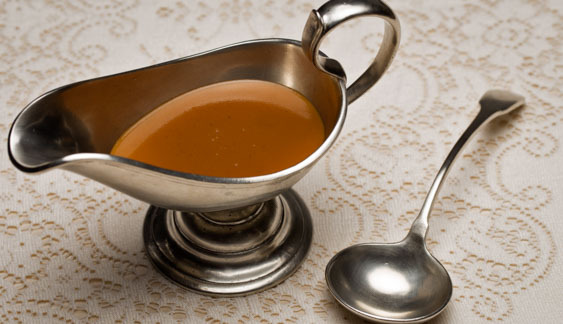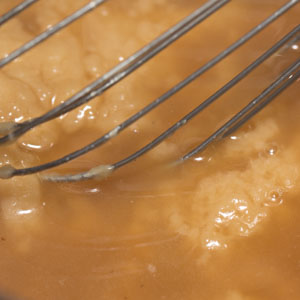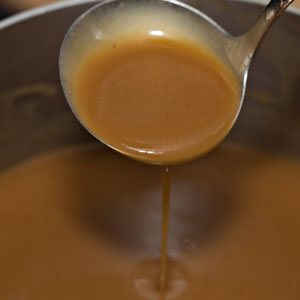Madeira Gravy for Roasted Turkey

introduction
Turkey pan drippings, like pan drippings everywhere, possess excellent flavor and plenty of free time. Once the turkey is carried off to its reposing station or carving board, pan dripping are just there, ready to be deployed in a sauce or scrubbed out of the roasting pan and rinsed down the drain. Using them would seem to be indicated. Yet we have mixed feelings about pan drippings, recalling with distaste the number of occasions when, company-ready and clad in cashmere, we have stood over a splattered roasting pan, trying to deglaze, degrease, and deliver pan drippings from their native state into a smooth, satiny sauce. The stains! The burns! The barely-above-average results. And never enough gravy! Never enough gravy.
Years back we started seeking out fresh or frozen raw turkey bones of whatever persuasion—backs, necks, feet—from local farmers who raised turkeys. In more recent years, we’ve also ordered frozen necks online. We make a rich brown turkey stock and freeze it well ahead of Thanksgiving. Pan drippings? Yes, from the bones roasted for the stock. The gravy can be coddled along on the stove completely out of contact with the roasting turkey, and finished well in advance of the dinner. Thus, instead a pan gravy, we get a great gravy.
Before everyone starts screaming, we do deglaze the turkey pan drippings. At our leisure—and wearing an apron. But they get refrigerated, the fat chills and can be peeled off, and, thus, another gravy waits just around the corner—after we’ve made a new batch of stock with the carcass.
Back to the gravy. In the service of this delicious, clear, rich-brown turkey stock, we put a shallot and mushroom–infused Madeira reduction to work. Flavor layering at its finest! And, lest you think this gravy gets off without an Anson Mills ingredient, think again: gravy without a smooth, velvety roux would be mere soup broth. Our pastry flour performs skillfully and masterfully in a roux. And, yes, even in a roux, it tastes noticeably superior to commercial flour.
This gravy has deep, rich round flavor with the woodsy flavor of cremini and a sweet little shiver of Madeira in its final flavor. Every item on the plate to which it flows will be grateful.
Better get busy.
Cooking Remarks
Fat skimmed off the chilled turkey stock is an excellent source of flavor and can be combined with some of the butter in the gravy’s roux, should you be so inclined. Schmaltz is animal fat like butter, after all, and has the advantage, in this case, of being infused with flavor from aromatics in the roasting pan. Some of the necks we roasted produced a good amount of fat; others did not. Maybe you’ll get lucky, maybe not.
Color-wise, we didn’t push the roux into gumbo terrain, but kept it fairly light. The stock has color and flavor enough not to require the presence of a dark roux.
equipment mise en place
For the stock, you will need a small flameproof roasting pan (preferably one with handles), a pair of tongs, a heavy-bottomed 6- to 8-quart stockpot, a fine-mesh sieve, and a large heatproof bowl.
For the gravy, you will need a heavy-bottomed medium saucepan, two heavy-bottomed small saucepans, a whisk, and a fine-mesh strainer.
-
for the stock:
-
1¼pounds turkey necks, drumsticks, or wings
-
1medium yellow onion, chopped
-
1small carrot, peeled and chopped
-
2medium celery ribs, chopped
-
10garlic cloves, peeled and halved (green sprouts removed, if present)
-
2½quarts spring or filtered water
-
2teaspoons dried thyme
-
1Turkish bay leaf
-
Stems from 1 bunch flat-leaf parsley
-
12black peppercorns
-
-
for the gravy:
-
6tablespoons (3 ounces) unsalted European-style butter or a combination of butter and reserved fat from the turkey stock, plus 1 tablespoon (0.5 ounce) unsalted European-style butter
-
3.6ounces Anson Mills Colonial Style Fine Cloth-Bolted Pastry Flour, whisked to aerate
-
1.5ounces shallots (2 large), peeled and minced
-
4ounces cremini or button mushrooms, stemmed and chopped
-
¼cup chopped flat-leaf parsley
-
⅔cup Sercial Madeira
-
1wide strip orange zest
-
2tablespoons tamari or soy sauce
-
Fine sea salt and freshly ground black pepper
-
-
Adjust an oven rack to the middle position and heat the oven to 425 degrees. Arrange the turkey parts in a single layer a small flameproof roasting pan (preferably one with handles) (fig. 1.1) and roast until mahogany brown and crisp, turning once, 1 to 1½ hours. Sprinkle in the onion, carrot, celery, and garlic and use tongs to toss the aromatics in whatever turkey fat has collected in the pan. Continue roasting until the vegetables are soft, fragrant, and brown tipped (fig. 1.2), turning the turkey parts once, 45 to 60 minutes longer.
-
Using tongs, transfer the bones and aromatics to a heavy-bottomed 6- to 8-quart stockpot. Place the roasting pan over a burner, turn the burner to high, and pour in 2 cups of the water. Use a wooden spoon to scrape up the browned bits on the bottom of the roasting pan, then transfer the liquid to the stockpot. Pour in the remaining 2 quarts water and add the dried thyme, bay leaf, parsley stems, and peppercorns. Bring to a simmer over medium-high heat, and then reduce the heat to medium-low and simmer gently until the stock is rich in flavor, about 3 hours, adjusting the heat as needed to maintain a soft simmer.
-
Strain the stock through a fine-mesh sieve into a large heatproof bowl (fig. 3.1); discard the solids. You should have about 1½ quarts of strained stock. Let cool to room temperature, and then cover and refrigerate until the fat congeals on the surface, at least 3 hours or for up to 2 days.
-
Make the gravy: Remove the congealed fat from the surface of the chilled stock and reserve it if you plan to use it in the roux. Transfer 4 cups of the defatted stock to a heavy-bottomed medium saucepan and bring to a simmer over medium heat. Turn the off heat and cover the saucepan; leave the pan on the stove.
-
Melt the 6 tablespoons (3 ounces) butter or butter–turkey fat blend in a heavy-bottomed small saucepan over medium heat. Add the flour and stir with a wooden spoon to form a thick, smooth paste. Cook the roux, stirring constantly, until the smell of raw flour diminishes, about 5 minutes. Continue cooking until the roux turns the color of straw (fig. 5.1), about 5 minutes more. Remove the pan from the heat, cover, and set aside.
-
In a second heavy-bottomed small saucepan, melt the remaining 1 tablespoon butter over medium-low heat. Add the shallots and cook, stirring frequently, until translucent, about 5 minutes, lowering the heat if necessary to make sure they do not color. Add the mushrooms and cook, stirring frequently, until they soften and release their juices, about 5 minutes more. Stir in the parsley (fig. 6.1). Increase the heat to medium, pour in the Madeira, and bring to a simmer. Simmer gently to evaporate the alcohol and infuse the aromatics, about 5 minutes; do not induce a full boil.
-
Pour the Madeira reduction into the pan with the warm stock and bring to a simmer over medium-high heat. Reduce the heat to medium-low and whisk a spoonful of the warm roux into the hot liquid, and then allow the liquid to return to a gentle simmer while whisking to smooth out any lumps (fig. 7.1). Continue to add roux in this manner, allowing the liquid to return to a light simmer after each addition, until you’ve added about two-thirds of the roux. If the gravy is not yet as thick as you’d like, add roux in smaller increments, still allowing the mixture to return to a simmer between additions, until it has reached the desired consistency. Simmer the gravy slowly over low heat, stirring frequently and skimming occasionally, until the raw flour taste is cooked out and the flavors come together, about 10 minutes. Stir in the tamari and orange zest, remove from the heat, and let steep for 5 minutes. Season to taste with salt and pepper.
-
Pour the gravy through a fine-mesh strainer into a vessel of your choice depending on your immediate plans for the sauce—warmed sauceboat or saucepan—pushing down on the solids to extract every drop. Serve immediately (fig. 8.1) or set aside and rewarm before serving. (You may also freeze the gravy for up to 1 week, thaw it, and warm it before your holiday meal.) If the gravy at any time becomes too thick, thin it with a touch of turkey stock or water.
-
-
1.1

-
1.2

-
-
-
3.1

-
-
-
5.1

-
-
-
6.1

-
-
-
7.1

-
-
-
8.1

-